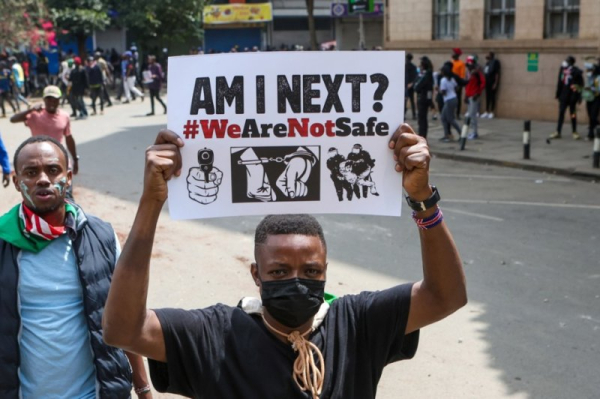

A demonstrator displays a placard Wednesday during a protest in the central business district of Kenya’s capital city of Nairobi. The protest marks the first anniversary of the Gen Z protests, which culminated with the storming of the national parliament which left dozens dead at the hands of Kenyan police forces. Photo by EPA.
Television stations were forced off air as thousands flooded the streets in Kenya across the African nation to demand President William Ruto’s resignation a year after mass protests over a controversial tax bill left dozens dead after citizens stormed the Kenyan parliament.
“Many of us are being killed with no reason,” 24-year-old security guard Don Cliff Ochieng told The New York Times Wednesday, saying he was in Nairobi due to police brutality and lack of economic opportunity as banks, business and schools are closed due to fear of violence and major roads closed leading into Kenya’s capital city.
Unconfirmed reports by multiple news outlets indicated at least two people were shot dead Tuesday and Wednesday during protests in Mattu, about 65 miles from the Kenya’s capitol Nairobi where at least 50 protesters reportedly were injured as nationwide protests erupted to mark the first anniversary of last year’s deadly demonstrations.
“It is our right to demonstrate,” added Ochieng.
Meanwhile, the Kenyan government has banned live protest television coverage with the privately owned NTV and KTN stations reporting that police officials raided its transmission center and “unconstitutionally” switched off broadcast signals.
“This action has been taken without notice,” NTV’s parent company Nation Media Group stated Wednesday. “The shutdown of NTV is a direct interference of our editorial operations,” the statement read in part.
Kenyans hit the streets in June 2024 in oppositon to Ruto’s tax bill proposal, which passed but Ruto backed off from, to raise an additional $2 billion in needed revenue, which sparked fears of cost of living increases on daily services and goods.
Last year’s bloody clampdown by Kenyan security forces left at least 65 people dead with thousands arrested and 89 reports of some still missing persons, according to Amnesty International. However, the Kenyan government claimed the death toll at 42 casualties.
This week, Kenyan police utilized water canons and tear gas to disperse protests, which again started earlier this month spurred by the questionable death in police custody of teacher and blogger Albert Ojwang, in marches largely lead by angered Gen Z Kenyans fuled over Ruto’s perceived arrogance, lack of accountability, economic hardship and string of failed campaign promises to help the poor.
Kenyans “are not feeling heard and there’s a sense that things have not really changed since the protests last year,” Meron Elias, an East Africa analyst at the nonprofit group International Crisis Group, told NYT. “They want to remind the government that this is not a problem that will easily go away.”
Ruto became president in 2022 and since then salary taxes have spiked in addition to a doubled fuel tax with Kenyans now paying a housing levy and tax on health insurance.
On Wednesday, protestors in Nairobi yelled “Ruto must go!” as some carried roses and photos of victims killed last year after a man last week was shot in the head in demonstration against police violence.
Kenya’s top law enforcement official, Douglas Kanja Kirocho, urged the public on Tuesday to “refrain from provocative acts directed at police officers in the execution of their duties,” he said in a statement.
In a television speech that day in Nairobi at his official residence, the beleaguered president retired his support for the police.
Kenya’s National Police Service Commissions stated its expectation that its officers will uphold the “highest standards of professionalism and restraint.”
“You cannot intimidate the police. You cannot use force against the police, or insult or threaten the police. You are threatening our nation,” Ruto said in his speech to a group that included cabinet ministers.
However, Kenyan news sources issued reports of people in civilian clothes with weapons accompanied by police as last week’s protests were extinguished.
On Tuesday, a joint statement by 12 nations, including the United States was critical of the use of “plainclothed officers in unmarked vehicles” and further stated disappointment over the “use of hired ‘goons’ to infiltrate or disrupt peaceful gatherings.”
“We are honoring them,” Joann Nancy, a 21-year-old student, told the Times. “I am just hoping nobody gets killed.”